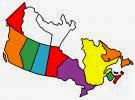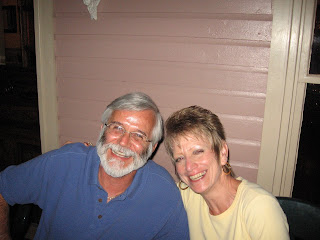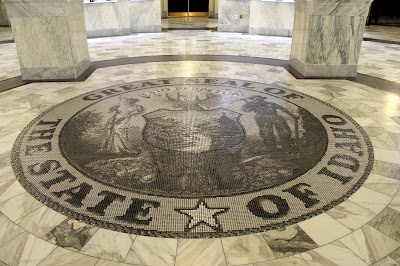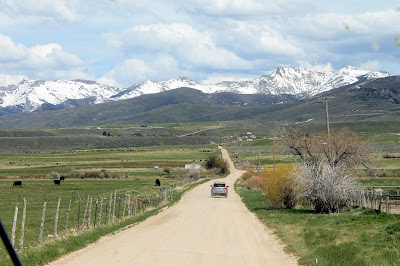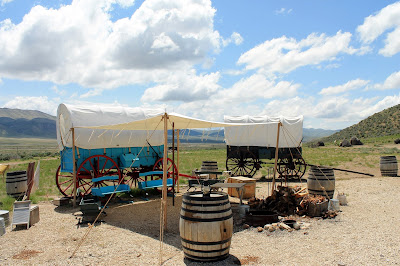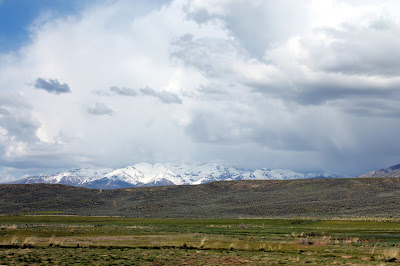We have decided that our travels as we head east will be about touring capitols. With Utah and Idaho done we next headed to Helena. That was over 550 miles so it took a couple of days. We spent the first night at the Elks in Idaho Falls, a great deal at $10.00 for a water and electric site.
From Idaho Falls we stayed off the interstate and took the two lane roads into Montana. That route took us on the back side of the Tetons. Beautiful mountains and lots of farm land.
This is the back side of Earthquake Lake that was formed in 1959 when an earthquake caused 80 million tons of rock to block the Madison River. The slide killed 28 campers and dammed the river creating the lake. The brown is the rock slide with the snow capped mountains of Yellowstone in the background.
Look! A herd of Montana wild horses. Well, not really, it is a herd of artwork.:-)
The center part of the Montana capitol was built between 1899 and 1902 in the American Renaissance neoclassic style. Two new wings were added between 1909 and 1912. The original part was built with sandstone and the additions with granite so they are different colors.
The capitol has the dome that is typical of this style.
The skylight and the window in the main staircase are beautiful stained glass. As was done in other capitols, at one point the skylight was painted over. The painting above is Driving of the Golden Spike. It shows the completion of the Northern Pacific Railroad, the second transcontinental railroad, in Gold Creek, Montana.
The statue on the left is Wilbur Fisk Sanders, a lawyer and Montana's first U.S. Senator in 1889. Center is Mike Mansfield who was the longest serving U.S. Senate Majority Leader, 1961 to 1977 and the the longest serving U.S. Ambassador to Japan, 1977 to 1988. He is with his wife Maureen because he would not agree to the statue unless she was included. Right is Jeannette Rankin who represented Montana in the House of Representatives for two terms, one from 1917 to 1919 and the other from 1941 to 1943. She was a pacifist and joined fifty other members in voting against the U.S. entering WWI and was the only member of Congress to vote against our entry into WWII.
One unique feature of the building, unlike other capitols built with two symmetric wings, one for each house of the legislature, Montana's has both houses in one wing and the executive branch in the other. The fifty members of the House of Representatives are elected to two-year terms. Something else unique about Montana is the legislature only meets for ninety days every other year so the members are up for reelection after each session. This chamber is undergoing renovation so it was not open.
The painting in the house chamber is Charles M. Russell's Lewis and Clark Meeting Indians at Ross Hole. It shows an event that happened on September 4, 1805. Interestingly the Indians, whose land it was, are given center stage in the painting while Lewis and Clark are small figures on the far right. The mural is so large that Russell had to raise the roof of his studio to paint it and it is the largest mural he ever painted.
This room was the original Senate chamber until the new wings were added in 1912. It then served as the Supreme Court until 1983. It is now a committee room. The columns here are hollow so they could run wiring through them. They are painted in the scagliola style used in many buildings to look like marble.
There is a lot of interesting art in the building about Montana history. When the capitol was built they hired interior decorators rather than an artist so some of the works are less then historically accurate. Top are Custer's Last Battle and The Louisiana Purchase which shows Jefferson and Napoleon together signing the agreement. That did not happen. Center is Lewis and Clark at Three Forks. Bottom left are The Chase of the Buffalo and Farewell to the Buffalo. Notice the train in the background in Farewell. Bottom right are Gates of the Mountains and Emigrant Train Being Attacked by the Indians.
This room that was originally the House chamber has been the Senate chamber since 1912. Montana has 50 senators that are elected to four-year terms. The chandelier is original. Behind the rostrum is a bronze relief We Proceed On which commemorates the bicentennial of Lewis and Clark's passing through Montana.
On the grounds of the capitol is a statue of Thomas Francis Meagher, an Irish Revolutionary and Union Army Officer who twice served as acting territorial governor of Montana.
View of Helena and the capitol.
Across from the capitol the Montana Historical Society has a museum that traces the history of the state from the time of the Native Americans through the early European settlers. The importance of the buffalo is pointed out as you come to the building with this large buffalo skull.
Many of the exhibits show the way the Native Americans killed and used the buffalo. In the early times they did not have horses, making the hunt very dangerous.
The safest way to kill the buffalo was to run them over a cliff to injure them and then kill them.
Big Medicine was born on the National Buffalo Range in 1933. Many of the natives considered a white buffalo to have supernatural powers that would pass to the family of the man who killed it. Big Medicine was not a true albino because he had blue eyes and tan hoofs. He was given special care and lived until 1959, much longer than normal.
The bands that obtained horses from early Europeans became more powerful as it was easier for them to hunt, move their camps and the horses also gave them a real advantage in battles. The Blackfoot were one of the first to acquire horses.
Native headdress and beaded clothing.
Another section has an extensive display about Lewis and Clark and there Corps of Discovery. They passed through Montana in 1805 heading west and on their return in 1806. Some of the corps used different routes on the return so they explored a great deal of the state.
A typical settler's home in the early 1900's. There are also displays on farming, mining and the railroads and the roles they played in the economy of the state.
The parlor of an upper class city family.
The museum has an great collection of the works of Charles M. Russell. We have always liked his work and toured his home and studio in Great Falls in 2012. Here is a link to our post about that visit.
Here are some of our favorite Russell works. You sure realize the big role the buffalo played in the history of the state when you visit here.
I loved this diorama. The stage and horse are a sculpture with the mountains painted in the background.
The detail of his work is fantastic.
Much of his work shows his sense of humor. He would often draw pictures when he wrote letters to his friends.
Another day we drove to the Gates of the Mountains that is in one of the pictures above. Unfortunately, you can't see them unless you go in a boat and it was not yet open for the season.
We had a great stay in Helena and, as usual, we learned a lot of Montana history. We also checked out a couple local breweries and were not disappointed. If you are passing nearby, Helena is worth a few days of your time.
As usual, we are a little behind with the blog and are now in Bismarck, North Dakota over Memorial Day weekend. Our travel plan is still not settled other than we will been in North Carolina in the middle of July. We hope to add a couple more capitols along the way and meet up with some friends.
